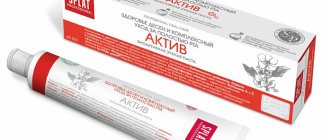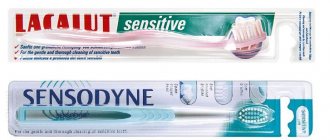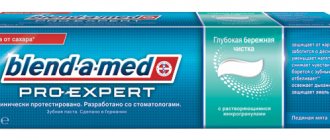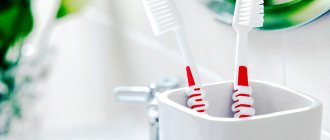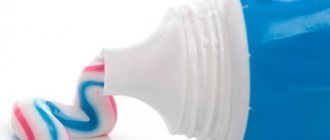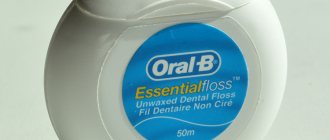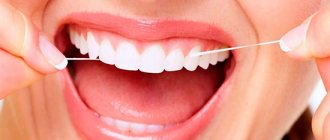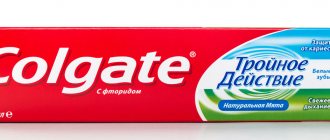Fluoride in toothpaste: benefit or harm?
The war against fluoride in dentistry began in the middle of the last century in the United States. More precisely, this country was the first to begin fluoridating drinking water in order to strengthen the population’s tooth enamel. Then, in 1969, the technique received WHO approval, and many countries around the world began to adopt advanced American experience. Only after a wave of fluorosis (a chronic disease caused by excess fluoride in the body and affecting not only teeth, but also skeletal bones) swept America in the 70s, the feasibility of water fluoridation was called into question. Despite the fact that at the beginning of the 21st century, reputable scientists, including the Australian researcher W. Evans, came out in support of fluoridation, discussions about the benefits of fluoride in medical circles continue to this day.
So is fluoride in toothpaste actually harmful, or are rumors about its negative effects on humans greatly exaggerated? Let's try to dot all the i's in this issue.
Parodontax toothpaste. Which is better, WITH FLUORIDE or WITHOUT?
Good day to everyone who reads my reviews.
I decided to dedicate this review to Parodontax paste , and the main thing is to figure out which paste is better, with or without fluoride.
But first I will tell you my story.
Two years ago, some dark spots began to appear on my upper teeth. At first they were insignificant, then they began to increase little by little. I decided that my teeth just needed to be whitened and was in no hurry to go to the dentist. And in vain. I bought whitening strips, used several, found that there was no effect, and the spots continued to grow. Then I thought about it and started reading information on the Internet. I read about root caries and its consequences, was horrified and immediately ran to the dentist. My worst fears about tooth decay came true. But it was caries at the initial stage, plus the enamel of my teeth was thinned. On top of everything else, for some reason my gums became loose and bled a little. The dentist prescribed me treatment for my gums, sanded the front surface of my teeth and removed these stains as much as possible. And she strongly recommended Parodontax paste with fluoride to strengthen tooth enamel, remineralize it, and prevent gums from crawling.
Now let's try to figure it out.
Fluorine is a chemical element, a gas. In nature, it occurs in the form of compounds with various substances. These compounds are called fluorides. There is a myth that fluoride in toothpaste is dangerous. This myth is based on rumors that fluoride is dangerous to humans even in small concentrations. Such myths work due to the fact that people want to see some kind of mystery in ordinary things and at the same time often judge areas where it is impossible to understand without special knowledge.
I read that at the beginning of the twentieth century, scientists clinically proved that fluoride prevents the occurrence of caries, as well as the proliferation of harmful bacteria in the oral cavity. Therefore, since one thousand nine hundred and forties, in many countries, municipal programs for additional fluoridation of tap water began to develop in order to prevent caries in the population. And then rumors spread about the dangers of fluoride.
It is worth recognizing the fact that in high concentrations, fluorine is really dangerous, like any other trace element in overdoses. But all this does not mean that we need to avoid any ingestion of fluoride into the body, since then we would have to give up green and black tea, apples and other natural products rich in fluoride and beneficial to humans. The main thing is to understand: for fluoride to harm our body, we need to work more than ten to fifteen years in the production of fluorides in violation of safety regulations. It is impossible to obtain a significant dose of fluoride in household doses from food or water, but due to a lack of fluoride, health problems can quite realistically arise.
Indeed, there is such a disease as flurosis, which occurs from an excess of fluoride. There are two varieties of it. Endemic fluorosis almost always develops in the womb or in early childhood before teething. Manifestations of endonemic fluorosis are immediately noticeable - these are uneven white spots on the teeth, which gradually darken and become similar to caries. And the second type of fluorosis is professional systemic fluorosis. It can only occur in workers involved in the production of fluoride when working conditions are violated. It manifests itself in damage to bones and internal organs. But the appearance of the teeth does not change.
Fluorides are simply necessary for teeth: they inhibit the activity of harmful bacteria and prevent their waste products from corroding tooth enamel. Hence the conclusion that fluoride in toothpaste prevents tooth decay. Damaged areas of the tooth are remineralized due to the action of fluorides, therefore, from fluoride, early caries “heals before our eyes.” And we must understand that it is not the fluoride content that is harmful, but its quantity.
Only you can decide which toothpaste to buy, with or without fluoride. You can consult your dentist. I have made my choice. For 2 years in a row I have been buying Parodontax paste with fluoride, sometimes taking a break for something else so as not to become addictive. But then I return to this pasta again. Because it cleans teeth well, solves not one problem, but three at once: protecting teeth from caries, reducing bleeding gums and remineralizing teeth. And now the manufacturer has released it with a new taste, which is now very pleasant and unobtrusive compared to what it was before.
Fluorine and fluorides are not the same thing
Often, opponents of the use of fluorine confuse key concepts: fluorine is a reactive gas that is poisonous to the human body, and fluorides, its octane-based derivatives, are absolutely harmless. Only fluorides (such as sodium fluoride) are used to make toothpaste. Moreover, their concentration in a tube of paste is strictly regulated.
ATTENTION! According to regulations, the permissible concentration of fluoride in toothpaste ranges from 1350 to 1650 ppm. This indicator depends on whether the paste is therapeutic and prophylactic or is intended purely for the prevention of caries (1ppm = 0.0001%).
Distinctive features of periodontitis and periodontal disease
For ease of perception, we have collected the signs, causes and consequences of periodontitis and periodontal disease in a table:
| Criteria for comparison | Periodontitis | Periodontal disease |
| Causes | Poor oral hygiene, dental plaque, a number of systemic diseases, poor family history, weak immunity | Possible development factors: heredity, gastrointestinal pathologies, atherosclerosis, diabetes mellitus |
| Frequency of propagation | Diagnosed in more than 80% of the population | Very rare (2-3% of patients) |
| Clinical manifestations | Inflammatory process | Dystrophic tissue changes |
| Character of the course | The symptoms are pronounced, the inflammatory process develops quickly | Most often it is asymptomatic or indolent |
| Localization | May affect individual teeth or the entire jaw | Always affects both jaws |
| Bleeding gums | Is the first symptom | In most cases it is not observed |
| Tooth mobility | May be present at first, but with proper treatment it is completely eliminated | Appears very late, when the periodontium is affected by half or even more |
| Periodontal swelling | Present in most cases | Not visible |
| Presence of pockets of dentogingival localization | The depth of periodontal pockets depends on the severity of the pathological process | May be shallow or completely absent |
| Increased sensitivity of enamel | Individual necks of teeth may become exposed | Accompanied by chipped enamel in the cervical part |
| Teeth position | With moderate to severe periodontitis, fan-shaped divergence of teeth may occur. | Clear gaps appear between teeth |
For periodontitis, if treatment is selected correctly and started immediately, the patient can count on rapid elimination of symptoms and stopping the progression of the pathology. And since periodontal disease is a systemic disease, without obvious clinical signs, to achieve stable remission the patient needs lifelong preventive therapy.
It is important to choose the right toothpastes for daily oral hygiene in such pathologies. Ideally, it should be recommended by a dentist based on the condition of your gums and teeth. Medicinal toothpastes should be a priority. They may be marketed as anti-inflammatory or anti-bleeding gums. In this review we will look at the best of them.
Fluoride in toothpaste and water are different things
The dangerous disease fluorosis occurs due to the accumulation of fluoride in tissues if it enters the body with water. According to GOST, the fluorine content in water can vary from 0.5 to 1 milligram per liter, depending on the geographic region. It is physically impossible to be poisoned by fluoride through toothpaste, since fluoride is not absorbed in the oral cavity. For this to happen, you need to eat fluoride toothpaste on a regular basis instead of using it for its intended purpose.
Fluoride is a real protection against caries
Today, there are dozens of scientific papers proving a positive relationship between the use of fluoride in toothpaste and the remineralization of teeth. It's simple: fluoride ions are not destroyed in an acidic environment, penetrate the structure of tooth enamel and, combining with calcium crystals, prevent its destruction.
Thus, if you are faced with a difficult choice of toothpaste with fluoride, the best solution would be to make it under the guidance of your dentist, who will select a product with the required concentration of the substance, taking into account the condition of your teeth, region of residence and the presence of concomitant diseases.
Caries and toothpaste without fluoride
The purpose of brushing teeth twice a day is to eliminate the harmful effects on a person's teeth caused by bacteria that cause tooth decay. Is it possible to achieve this by using exclusively fluoride-free toothpastes every day? Most dentists are inclined to believe that this is 100% impossible. However, it is possible to find a compromise: for example, brush your teeth three times a week with fluoride-containing toothpaste, and the rest of the time use alternative methods.
- Get fluoride from food. One of the common misconceptions about fluoride is that, in addition to water, it can only enter the body from special toothpaste. In fact, in order to cover the body’s daily need for this chemical element (and it is 3.5 milligrams for adults and 0.5-2 milligrams for children), it is enough to regularly eat foods naturally rich in fluoride: green tea, seafood , cherries, beans, egg yolk.
- Use natural toothpastes. Let’s make a reservation right away: they can be considered “natural” conditionally. We are talking about pastes, the chemical composition of which, instead of fluorine, includes hydroxyapatite (a synthetic analogue of tooth enamel) and components of plant origin that have an antibacterial effect: mint extract, sea salt, mumiyo and others.
- Take pills... for caries. Yes, they exist and have long been proven to be 90% effective. Medicines are produced on the basis of lactobacilli, which inhibit the proliferation of cariogenic microorganisms, and as a side effect they also normalize the balance of microflora throughout the gastrointestinal tract.
- Only with a competent combination of several methods of prevention, observance of basic oral hygiene (implying the use of rinse, irrigator and floss in addition to toothpaste), as well as regular visits to the dentist for examination, the occurrence of caries can be successfully prevented.
Rating of the best children's pastes
- Splat Baby "Apple Banana". Suitable for children up to one year old. Along with the paste itself there is a special silicone brush that fits on your finger. In production, only natural ingredients are used, which makes it absolutely safe even if swallowed.
- Babycoccole . The manufacturer produces pasta in several flavors: strawberry, banana and apple. It does not contain any substances that may be harmful to the child or allergens. It has a pleasant taste, and most importantly, it prevents the development of caries.
- Chicco with strawberry flavor . Recommended for children over one year old. Does not contain fluoride, abrasives, is rich in calcium and xylitol, which prevents the development of caries.
- ROCS Kids "Citrus Rainbow" . Suitable for children aged 4 to 7 years. Its distinctive ability is the rapid formation of a protective layer on the surface of the teeth, which prevents the loss of calcium and phosphorus. Regular use reduces the likelihood of developing caries and inflammation of the gums, and also helps to normalize the microflora of the oral cavity.
- Biorepair Junior Mint – with sweet mint flavor. Recommended for use by children aged 7 to 14 years. It contains the proprietary micro Repair component, which has a protective effect and also restores microdamage to the enamel.
Toothpaste must be safe and of high quality. It should not contain sulfates, antibacterial substances, dyes, or flavors. Should be rich in calcium and lactic enzymes. Choosing the right toothpaste will improve the quality of your child's teeth and help you avoid expenses at the dentist's office. .
Forewarned is forearmed!
Let's summarize: the harm to human health from using toothpaste with fluoride today cannot be considered a scientifically proven fact. Research in this direction is carried out regularly around the world, and its results can be found from open sources. It’s up to you to decide which product to choose for daily oral care for yourself and your loved ones. But when making such a serious choice, remember two important nuances.
- Fluoride is poison, and fluoride is medicine.
- Excess fluoride leads to fluorosis, while its deficiency makes the way for caries easier.
